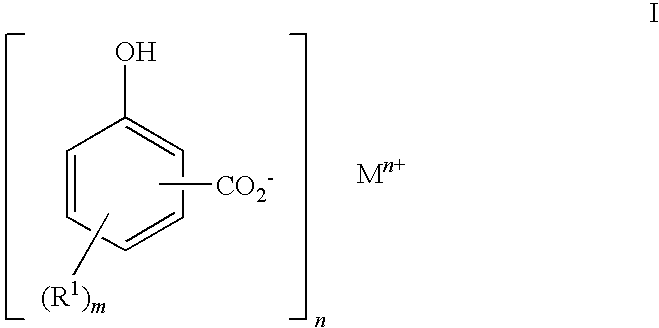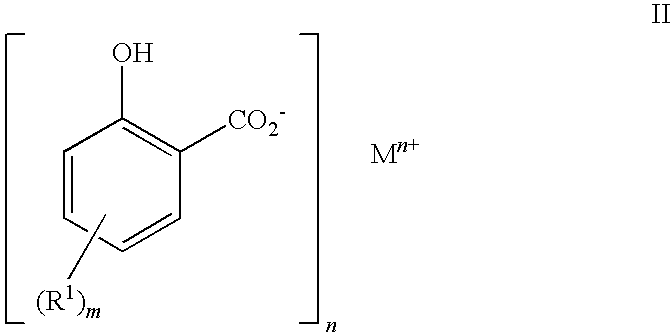Detergent
a technology of hydroxybenzoate and detergent, which is applied in the preparation of carbonyl compounds, anionic surface active compounds, engine components, etc., can solve the problems of crankcase explosion and crack formation, and achieve the effect of superior reduction of asphaltene precipitation
- Summary
- Abstract
- Description
- Claims
- Application Information
AI Technical Summary
Benefits of technology
Problems solved by technology
Method used
Image
Examples
example 1
Preparation of 1-methoxy-4-(hexadec-1-yl)benzene
[0154]1-bromohexadecane (96.32 g) was transferred into a thoroughly dried 2 litre 3-neck flask, followed by Li2CuCl4 (0.1M in THF, 31.7 ml). The reaction flask was placed in an ice / water bath. The Grignard reagent (4-methoxyphenyl)magnesium bromide (0.5M in THF, 948 ml) was added dropwise over two days, stopping the reaction overnight. The contents of the reaction flask were mixed with toluene (300 ml) and poured into a separating funnel. 10% HCl solution was then added to acidify the mixture. Water (500 ml) was added and shaken with the toluene. The aqueous layer was washed with toluene (2×300 ml). The organic extracts were combined and washed with water (500 ml) and brine (50 ml) and then dried with MgSO4. The solvent was removed in vacuo to give the title compound as an off-white solid 108.86 g which was characterised by NMR.
example 2
Preparation of 4-(hexadec-1-yl)phenol
[0155]The alkyl anisole of Example 1 (40 g) was transferred to a dry 3-neck 1-litre flask under nitrogen. To this was added tributylhexadecylphosphonium bromide (12.69 g) and HBr (48% aq., 71.4 ml). The resulting thick suspension was warmed to 135° C. and stirred for five hours. Toluene was added and the reaction was transferred to a separating funnel. The organic layer was shaken with water and then the aqueous extract shaken with fresh toluene. The organic extracts were combined and dried with MgSO4. The solvent was removed in vacuo to give the title compound as a brown solid.
example 3
Preparation of 2-hydroxy-5-(hexadec-1-yl)benzoic acid
3.1 Phenation Step
[0156]The alkyl phenol of Example 2 (52.6 g) was weighed into a 3 litre 3-necked boiling flask and xylene (1000 ml) added using a measuring funnel. The flask was set up for distillation and nitrogen was blanketed over the mixture at 400 ml.min−1. Stirring was then started at approx. 400 rpm and the mixture heated with an oil bath set to 120° C. and an aqueous sodium hydroxide solution (50%, 9.53 g) was added dropwise. The temperature was raised to 160° C. and all the water removed using a Dean and Stark apparatus. After 4 hours the reaction was cooled to room temperature and left overnight.
3.2 Carboxylation Step
[0157]After cooling, the contents of the flask from step 3.1 above were transferred to a 2 litre autoclave. A 1 barg nitrogen gas cap was applied, stirring was started and increased to 550 rpm and the autoclave was heated to 138° C. When the autoclave reached 138° C., CO2 was added, the pressure was increa...
PUM
| Property | Measurement | Unit |
|---|---|---|
| boiling point | aaaaa | aaaaa |
| temperature | aaaaa | aaaaa |
| viscosity index | aaaaa | aaaaa |
Abstract
Description
Claims
Application Information
 Login to View More
Login to View More - R&D
- Intellectual Property
- Life Sciences
- Materials
- Tech Scout
- Unparalleled Data Quality
- Higher Quality Content
- 60% Fewer Hallucinations
Browse by: Latest US Patents, China's latest patents, Technical Efficacy Thesaurus, Application Domain, Technology Topic, Popular Technical Reports.
© 2025 PatSnap. All rights reserved.Legal|Privacy policy|Modern Slavery Act Transparency Statement|Sitemap|About US| Contact US: help@patsnap.com


